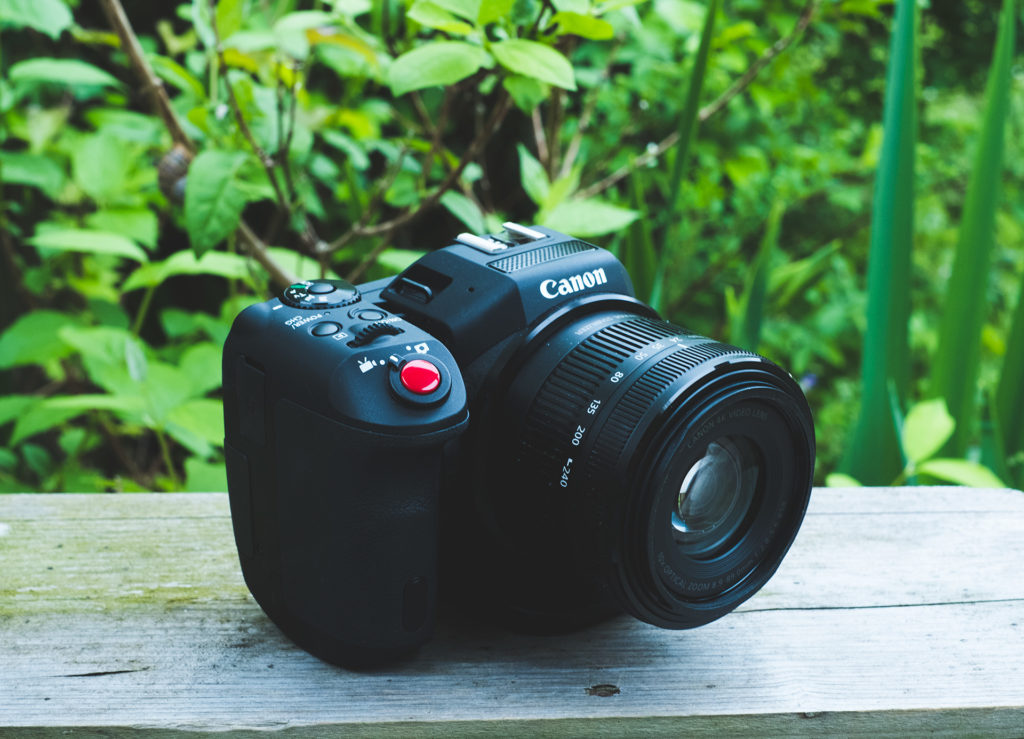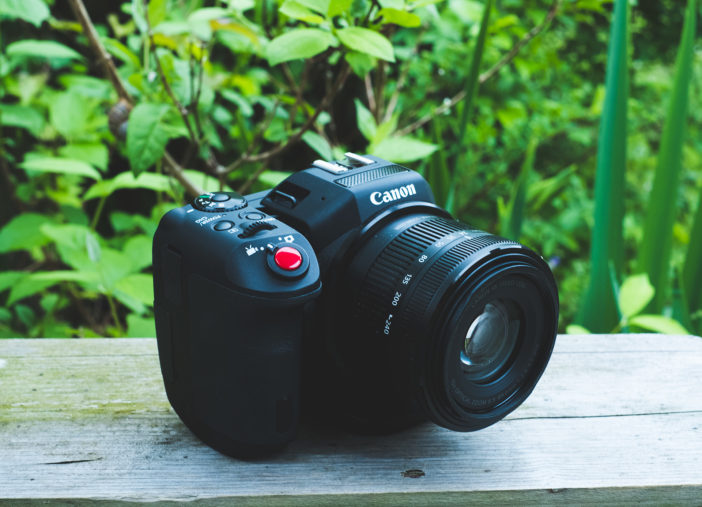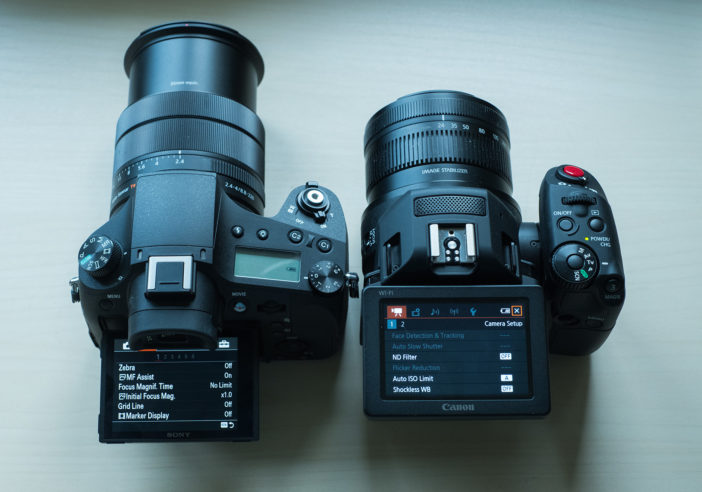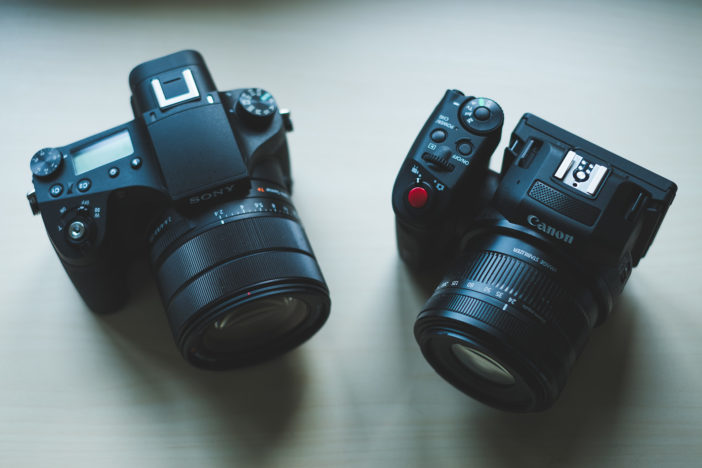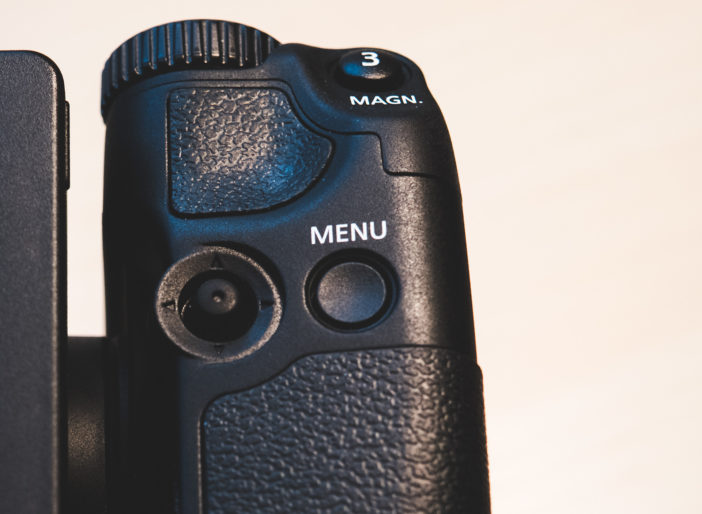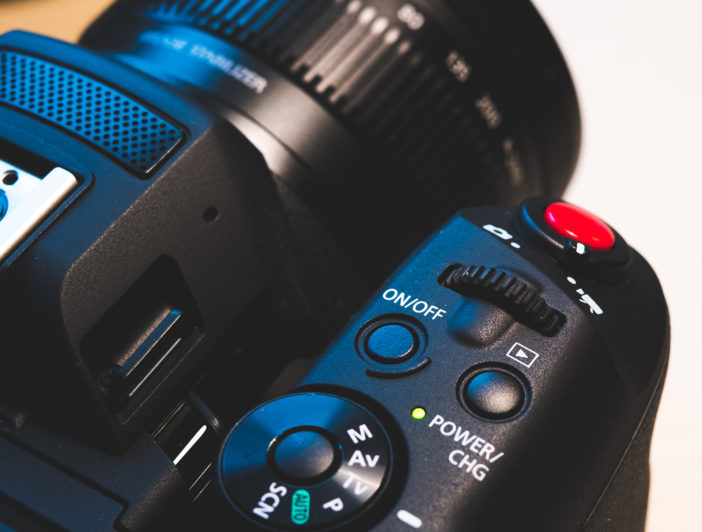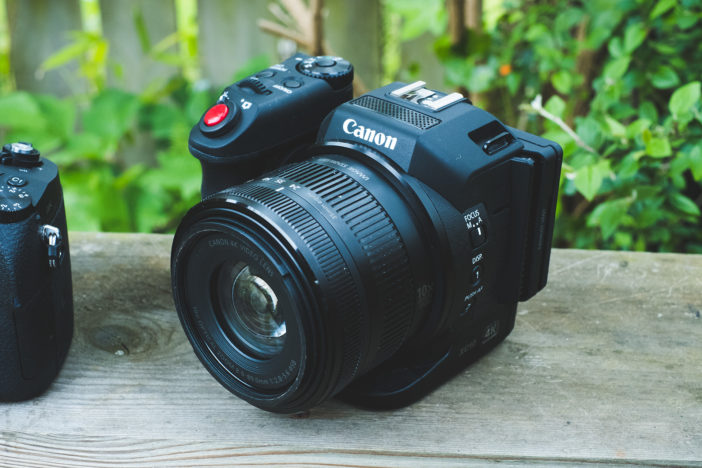The Canon XC10 is underrated on paper, not least by me! Having very little interest in one I decided anyway to give it a try.
Glad I did.
When Zeiss build a lens they do it at a very high technical level, but the also tune it subjectively to give it a cinematic look. It’s the same with cameras. What Canon do, in particular with regard to colour is that they don’t just ramp up the tech-specs, without tuning the image for a subjectively more pleasing result. When Sony build a camera they do so at a very high technical level, but they’re not currently applying an artisan touch in the lab. Never has this been more apparent with the Sony RX10 III.
The video specs of the RX10 Mk III remain broadly the same as 2015’s RX10 II and the RX100 IV. Out of those two I ended up choosing the RX100 IV as I felt it had an image quality advantage helped along by a very fast F1.8 lens at the wide end. It remains the best camera for 1080/120p continuous and 240fps cache record at a low price (with no competition on the slow-mo front for the price) and it fits in your pocket.
The Sony RX10 III doesn’t add S-LOG 3 or much new, but it does add a very good lens indeed.
The Canon XC10 and RX10 III have a few things in common – both their 1080p modes offer more features than the 4K mode. These are some of the best options for 1080p currently on the market under $2k. When it comes to 4K the XC10’s image superior to the Sony. It is however a bit more expensive – $1999 vs $1499. The Canon when it came out was actually $2500 and Sony seem to have moved away from any interesting low priced models since the A6000.
However, expensive though these models may be for a 1″ sensor camera, they have A LOT of abilities that larger sensor cameras don’t. Super 16mm is a classic film format, originally designed for documentary run & gun, a lightweight system with small zoom lenses. That is exactly what the Sony RX10 III and Canon XC10 are. They are the modern Super 16mm cameras with optics that allow you to get the shot in the moment with minimal fuss.
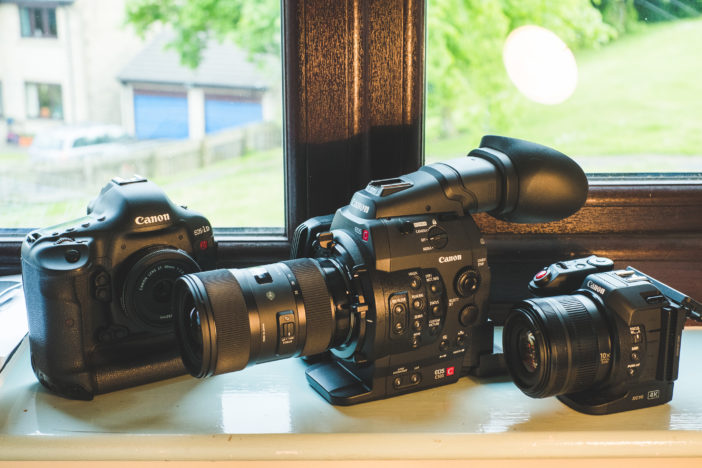
The lenses
I’ve seen much raving regarding the 24-600mm F2.4-4.0 lens on the Sony RX10 III from the usual suspects. When Barney of DPReview went hiking with it, it did seem to make perfect sense. Zoom in on that mountain, zoom out to wrap the trees around the trail. He said it was made with magic. Is it really made of magic?
With the previous model I was getting some very soft results in 4K, partly because the image processor in the RX10 II seemed to offer mushier compression as well. Things appear to be improved this time out especially the optics. Unfortunately OUT goes the constant aperture and OUT goes the built-in ND filter, which isn’t exactly magic for video shooters. And is a 24-600mm worth double the price of the Panasonic FZ1000’s 24-400mm? No!
Handheld past 400mm to 600mm the optical image stabilisation just can’t keep up in 4K mode. You must elect for a heavy sensor crop in 1080p with the active image stabiliser or lug a tripod around. In summary I think the 600mm is a bit overkill, I’d have been satisfied with a 24-300mm F2.8. That would be magic worthy of Harry Potter indeed.
The Canon XC10’s lens on the other hand isn’t as hype-able (is that a word?!), on paper it’s a 10x zoom, 24-240mm F2.8-5.6. The Sony is a 25x zoom. The devil is in the detail. It has astoundingly effective 5 axis stabilisation in 1080p and in 4K the 3-axis optical image stabilisation is superior to the RX10 III. It has a built in ND filter and a rather appealing rendering at the long end which gives it a much more cinematic look than F5.6 specs would suggest. Sharpness and contrast are both superb and stopped down you get some incredible sunstars. The XC10’s lens also handles better than the Sony-Zeiss ergonomically, with a mechanically coupled zoom ring making it extremely quick to navigate the full range of the lens and to do whip-zooms and quick corrections of the frame which look very ‘Super 16’. In fact this is one of my favourite features of the XC10 and it makes for a lot of fun.
The previous RX10 cameras had no zoom ring at all, nada. The RX10 III adds a fly-by-wire zoom ring, which as it turns out isn’t better than nothing. It is about as cinematic as a Thunderbirds puppet tangled up in its own strings. The RX10 III produces robotic zoom actions that lack the look of a human zoom-puller. The zoom rocker around the shutter button is more usable but still doesn’t lend the hand of the shooter to the manual zooms you can do with it, rather the hand of Johnny Five after 9 vodkas.
At maximum extension, the XC10’s lens is an order of magnitude more compact which helps the balance of the camera especially when shooting handheld. The RX10 III’s lens draws attention to itself like a man with a cricket bat in his trousers, at a funeral.
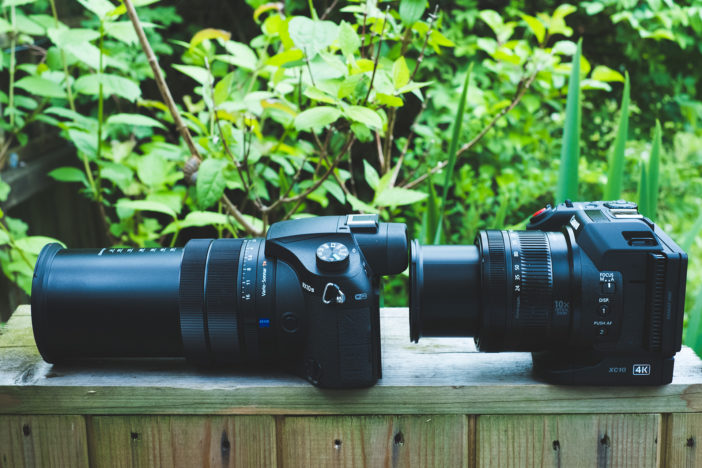
Image quality
The image processing pipeline and codec are very different between the two. The XC10 has a superb image which reminds me of a Super 16 version of the C300 Mark II, indeed it has the same fully featured 4:2:2 XF codec at 305Mbit in 4K mode and at least 12-stop dynamic range in Canon LOG.
The Sony RX10 III on the other-hand has a consumer grade codec, it’s not a professional one. I actually have no problem with that but in the comparison it falls down. In fact, the image processing is the straw that breaks the camel’s back for me as a Sony user – I’m no longer willing to put up with anaemic Rec.709 colour, awful white balance and difficult to fix S-LOG colour issues.
In 2015, Canon sneaked out a firmware update for the XC10 so quietly that even the 12 XC10 owners out there missed it! This firmware introduced a rolling shutter reduction mode for 4K, greatly reducing skew with clever image processing without requiring a crop like the reduction tool in Premiere.
So far then it’s a win for image quality, dynamic range and rolling shutter for the XC10 over the RX10 III – this coming from a regular Sony user who owns the A7S II, RX100 IV, FS5, A6300 and RX1R II.
In fact the XC10 is the first nice looking Canon camera for video they have released under $2000, in the past 4 years.
The only thing it doesn’t do as well as a Super 35mm or full frame camera is shallow DOF at wide angle in dim light. It doesn’t quite bring a dark room to life as much. However on a more controlled set with decent lighting and outdoors it is good enough to intercut with the C300 Mark II.
Where you need a shallow depth of field and a 24mm F1.4 at ISO 6400, go back to full frame.
Handling and fun stuff
The XC10 is also flat out more fun to shoot with than the RX10 III. It’s designed to be used in a semi-auto way, not full manual. This is great for run & gun, which remember is the main purpose of a Super 16-style camera.
Set to automatic the XC10 looks like most cameras do in full manual. Smooth exposure changes at exactly the right moment, no focus shimmering or unexpected jumps. No weird behaviour.
However for some reason, perhaps so they can sell you the Mark II version later, Canon elected not to put Dual Pixel AF on the XC10 which means the AF system can be slow to respond in some situations especially in low light.
In full HD you get proper tracking and object detection plus touch-screen AF. All this gets disabled in 4K and sometimes the camera will put the background in focus and not the intended subject. It can be hard to coax it in 4K without the touch AF.
The manual focus ring on the XC10 works unlike anything else I’ve ever used. It works when AF is engaged like a semi-automatic system where you can whip the AF into selecting the right thing. You can also do a very quick flick of the wrist and go from infinity to close-up in a nanosecond (although such violent wrist action does unsettle the shot). Nice though this is, if you try to use it like a normal focus ring with a longer slower travel, you get literally nowhere with it. The slower movements are for fine-tuning focus with the magnified focus assist on. The menu has a sensitivity setting for manual focus but this doesn’t make any meaningful difference. What the XC10 needs most of all is a firmware update that implements the option for a focus ring with linear behaviour.
The XC10 has an air intake and exhaust vent to cool the image processor, something Sony should start considering after the A6300 and the DIY fixes users have had to perform to get it through a shoot. Thankfully the fan is almost silent. The screen is superb and has better visibility in direct sunlight than the RX10 III’s.
There’s no EVF (this is Canon after-all!) but the loupe provided makes you realise why. In the few seconds it takes to snap on you gain something much better. The glass is of a very innovative design involving mirrors and all sorts of tricks; it supplies a much bigger and better EVF than the RX10 III has built-in. It’s almost worth covering up the touch screen for 🙂
When the touch screen is behind the loupe, a joystick is used for navigating the main menu and function menus. This has a secondary purpose, which I find rather useful – to switch quickly between 4K and HD with just a couple of presses without going into the menus.
The feel of the jog-dial on top of the camera is also very good. It’s silent, step-less and smooth but this is the ONLY dial on the camera which is something of a shame. I can’t assign it to exposure compensation when in A, S, P or auto mode, again something a firmware update should have solved by now.
Indeed when in manual mode the dial is only able to control one thing at a time – either the shutter, ISO or aperture depending on what you have assigned to it deep in the main menu.
Thus, the XC10 is designed to be used as follows:
In low light and indoors with no ND filter, select full manual mode and ride the ISO on the dial. The shutter stays at 180 degrees (1/50 for 24p) and the aperture stays wide open.
In bright light and outdoors, assign the ND filter to one of the side-buttons so you can instantly toggle it on and off with no menu diving. Rather than reprogramming the dial to ride the shutter or aperture, turn the mode dial to Av or Tv. In aperture priority the dial will stop the lens down if you find the scene is too bright for the ND filter to handle at 1/50. In Tv the shutter speed is all yours to control on the dial – here the camera tries to leave the aperture open unless the scene is too bright for an 180 degree shutter at F2.8 or F5.6 with the ND filter on… then it will stop down the lens automatically. If you ride the shutter to, say, 1/200 the camera will go wide open on the lens and the exposure should be correct even in the brightest direct sunlight at this shutter speed with the ND filter engaged.
On the RX10 III you find yourself using full manual controls more as the automatic behaviour isn’t as good, and you find yourself using very high shutter speeds outdoors as there’s no ND.
Although the XC10 could do with a small firmware update to allow the press of a side-button to toggle the behaviour of the dial (and allow exposure compensation to be assigned to the dial P,S,A modes), the Sony RX10 III needs a complete overhaul of both the physical control scheme and the firmware. The ergonomics of the RX10 III leave me cold. There’s the screen, which presents a thin, pixilated ‘compact camera’ style quality of image in stills mode and a much better one in movie mode. The discrepancy is disappointing because shooting video from stills mode has several ergonomic advantages over the actual movie mode itself… In movie mode you can’t shoot stills at all, the shutter button is useful for absolutely nothing, the AF slows to an unpredictable crawl with no way to half press for a quick snap-on AF. There’s no touch-screen to speak of, the main menu and physical buttons are again a mess, a mess which should have been sorted out a long time ago. The feel of the focus ring is all over the place. The zoom ring, a joke. The overall handling feels charmless and lacking in any kind of photographic DNA, the one remaining Minolta touch is the placement of the focus mode lever in an area you can’t even see when shooting. There’s no top dial for ISO or shutter speed, no dial on the front like a 5D3 or X Pro 2, just two tiny ones on the back that barely register under your fingers.
Media notes
Officially the XC10 records 4K to CFast 2.0 cards, however 1.0 cards seem to work too. Choose the 2.0 cards for the best reliability. Unfortunately it won’t record HD to CFast cards so you end up having to keep an SD card in the slot for 1080p. This way at least if you only want to shoot 1080p, you don’t have to indulge in expensive CFast cards!
The Sony RX10 III works best with 64GB (or larger) SDXC cards with fast write speeds, so you can enable XAVC-S 4K and the highest bitrate of XAVC-S 1080p recording. Be careful when using these cards in another camera, for the RX10 III has a tendency to forget where the Sony folder is, resulting in space for 0 stills flashing up on screen. The way to fix this is to re-select the recording folder in the main menus, option 107 of ten million on page 20,001. The dreaded PRIVATE folder structure is used for storing XAVC-S clips along with lovely high quality 720p thumbnails for each clip which are ignored entirely by the camera in playback mode! The playback mode of the RX10 III is 100% in-keeping with all other recent Sony cameras, in that it is shit. A pixilated mess when showing video clips in amongst stills, or a slow mess when switched to only show XAVC-S clips. In that mode it does use the high quality 720p thumbnails from the PRIVATE directory, with the only downside being that it makes you wish you’d never been born.
Summary
Apart from the things you can glean by looking at the box of the RX10 III – 1080/120fps, 240fps cache record, 4K, 24-600mm lens, overall the camera is a bit of a missed opportunity. This specs-race is all well and good, but is the RX10 III an enjoyable shooting experience? The lens is certainly a joy. The rest is not.
Anaemic colour profiles, poor ergonomics, fiddly menus, no ND filter, poor battery life and rather expensive.
Alternatives? There aren’t many to the 24-600mm Zeiss lens on the RX10 III but if the 600mm reach appeals so much, why not just put the Lumix 100-300mm on a GX85? That has a range of 200-600mm equivalent for about the same size and weight of the RX10 III but with much better stabilisation, better quality of 4K, larger sensor, better low light and for cheaper. The Panasonic GX85 has none of the ergonomic issues either and as a result it is more fun to shoot with. Provided you have some cash left over, add an SLR Magic 10mm or 12mm to cover the wide end.
What I DO like about the RX10 III is the 1080/120p – but it’s a lot of extra money over the Sony RX100 IV for the same thing isn’t it? The Panasonic FZ1000 also shoots 120fps 1080p with a super zoom lens (24-400mm), for $700. The main difference between the FZ1000 and RX10 III is that in 4K, the Sony does not crop from 24mm to 35mm and of course you have the superior 1080/120fps quality and 240fps+
The Canon XC10 on the other-hand has me eating a nice hat for dinner with a word sauce. When this camera came out nobody wanted to buy one. It has taken me a full 18 months to even contemplate it. I decided to try it in-store first and read many a report from people I trust on the EOSHD Forum. The image has something about it. The colour is very Kodak Super 16mm and the look is very Bolex/Kern-Pilliard but brought into the 4K era. The mechanical zoom ring is a joy, the simplicity of handling once you appreciate how it should be used and particularly the 1080p mode are a pleasure. The touch AF and tracking in 1080/60p is almost at Canon 80D level even without Dual Pixel AF and you rarely need to go into full manual mode at all to get the shot just as intended. The 5 axis stabilisation in 1080p especially is extremely powerful even for walking with, it’s a camera you can move around with on a documentary without a second thought to rigging. It feels like Canon used the XC10 to develop some genuinely groundbreaking technology. Top it all off with a Canon C300 Mark II standard codec, 305Mbit, 4:2:2 colour, best image processing on the market resulting in the best colour and LOG profile you can buy for under $2k, 12-stop dynamic range and respectable low-light performance.
In the end, you have a very able partner in your quest to find that lost tribe of 12 Canon XC10 users in deepest Papa New Guinea.
Canon XC10 summary
New (current street price): $1999 / £1450 (View at B&H)
Used price: $1500 / £1200 (View on eBay)
Pros
- Both 4K and 1080p image quality is top-notch
- Superb XF codec straight from the C300 Mark II – 4K at 305Mbit/s 4:2:2
- Canon colours are fantastic – best picture profiles on the market especially the vivid EOS Standard colours and flexible Canon LOG
- 4K rolling shutter reduction function works without cropping or softening image quality
- Uses Canon 5D Mark III batteries and new variety which charge in-camera, with reasonably long stints on one battery
- Superb live-view quality and touch screen LCD, which is bright and vivid both indoors and outdoors
- Sensible menus and clean presentation of on-screen shooting info
- Simple and effective controls layout
- Compact 24-240mm zoom doesn’t physically extend very far at the telephoto end
- Balanced and robust build quality
- Lovely Bolex feel to the manual zoom ring
- AF doesn’t look electronic, it is almost entirely without hunting, jittering or darting off suddenly
- Minimal rolling shutter in 1080/60p
- Rolling shutter reduction feature in 4K mode doesn’t crop the image or reduce sharpness!
- Bundled loupe makes for a superbly engrossing EVF when attached
- Beefy articulated screen construction
- Rotating grip ideal for shooting at extreme angles
- Good audio pre-amps and onboard stereo mic
- Audio-scene presets
- Extremely powerful dynamic 5 axis stabilisation mode in 1080p (with small crop)
- Very able 3 axis optical image stabilisation in 4K mode and 1080p (no crop)
- The 1080p is extremely sharp and detailed, not just at 24p but at 60p too
- Pre-record and slow & fast record (120fps 720p)
- Good timecode implementation
- Large start/stop trigger for movies in style of shutter release button
- Good touch screen implementation
- Very capable AF tracking and object detection in 1080p mode, also touch screen AF
Cons
- ISO 3200 and above only really acceptably usable in 1080p with Canon LOG enabled, avoid ISO 6400 in 4K
- AF can be slow to give you the shot in certain situations, especially in 4K mode
- Operation reliant on AF, since the manual focus ring is batshit crazy
- Touch-screen AF, object detection, tracking disabled in 4K mode
- Dual Pixel AF technology seems to be awol
- Ergonomic quirks include:
- Unconventional manual focus ring behaviour
- Turning Disp. info off disables Function menu on press of the joystick
- Exposure compensation cannot be assigned to top dial
- Only 1 dial on the entire camera
- Slow & Fast motion mode lacking the specs of the Sony. Only 720p in 120fps (conformed in camera)
- No RAW stills capabilities, on a Canon!?
- CFast cards required for 4K rather expensive, especially CFast 2.0
- 1-stop slower aperture at the telephoto end compared to RX10 III
- Slightly more expensive than the RX10 III
Sony RX10 III summary
New (current street price): $1498 / £1250 (View at B&H)
Used price: $1299 / £1150
Pros
- Much improved lens, far sharper than predecessor
- 24-600mm range longer than Panasonic FZ1000 and XC10
- Class-leading high frame rates up to 240fps in 1080p. Up to 1000fps at lower res.
- Highly detailed 1080/120fps continuous recording mode
- Fast AF in stills mode with 20MP raw capabilities
- Nice built in EVF
- Very versatile range of features
- Stepless aperture ring
- Solidly built body (although screen and card door feel more flimsy)
- Nice 12 stop dynamic range with S-LOG 2 (if you like suffering in post!)
Cons
- 4K video quality simply not as good as XC10
- No touch screen AF and sluggish focus in video mode
- In-camera colour profiles are still woeful with awful skin-tones
- S-LOG 2 is much harder to grade manually vs Canon LOG
- Disorganised menus take ages to get to what you want
- Lacks satisfying shooting experience (fiddly control scheme)
- 100Mbit 4:2:0 4K codec is weak by comparison to the XC10
- Battery life could be MUCH better given size of camera
- Poor screen visibility in daylight
- Live view display quality is pixilated in stills mode
- Dreadful playback mode
- Cannot assign main shutter release as movie start/stop trigger
- Zoom ring doesn’t feel right
- Zooms look too robotic
- Zooming when recording goes at a snails pace
- Lens is rather heavy and extends very far at the telephoto end resulting in a lack of balance
- Lens extends from body even at wide end
- OIS can’t cope with 600mm handheld, needs a tripod
- New lens jettisons built in ND filter and constant aperture
- RX100 IV gives the same image quality for much less money
- Lacks fast F1.8 wide angle of cheaper RX100 IV




